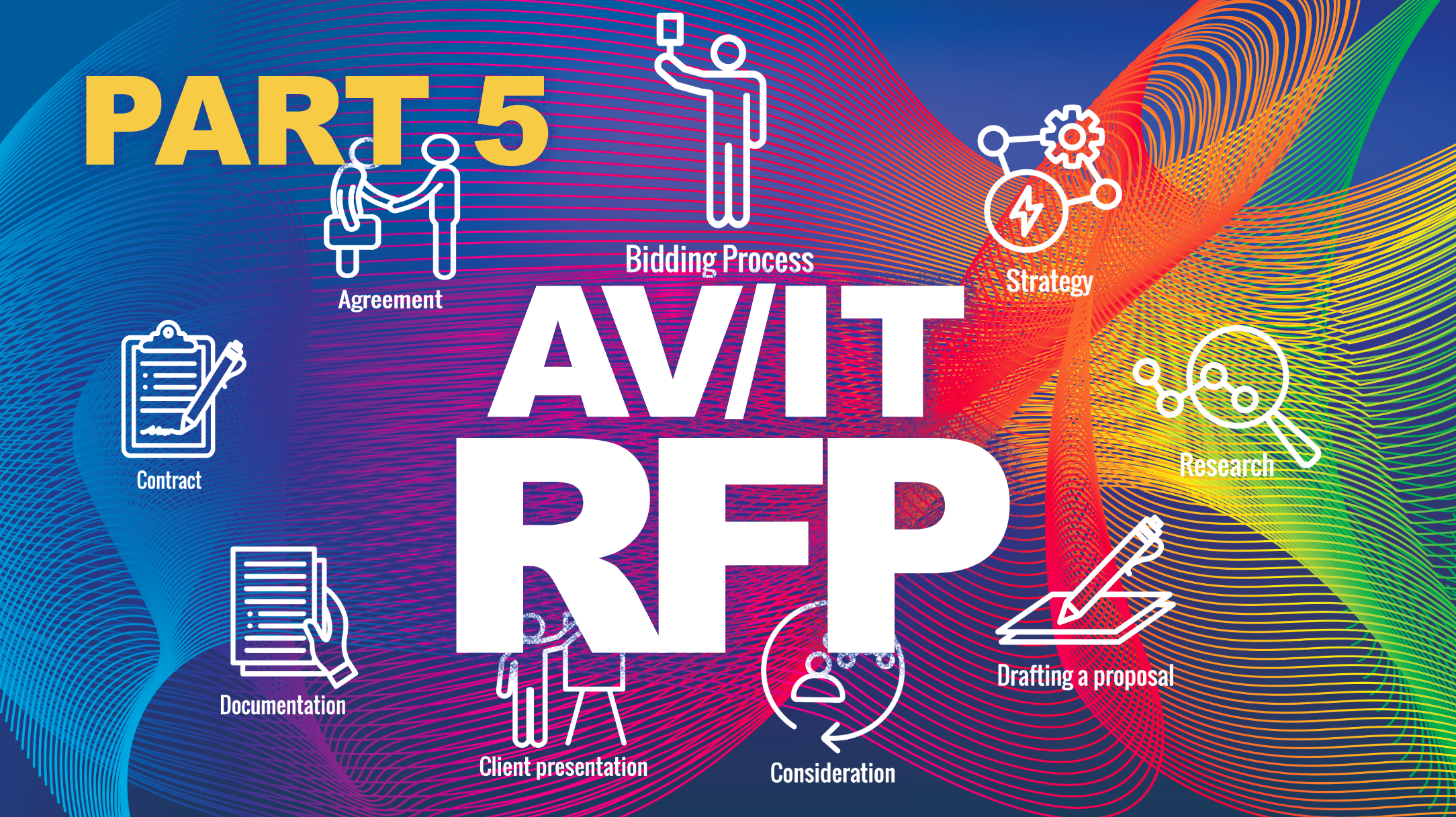AV Technology presents the five-part series of articles on Navigating a Successful Higher Ed AV/IT RFP Process, written by Joe Way, PhD, CTS, executive director of Digital Spaces at the University of California, Los Angeles’ Digital & Technology Services.
Are you currently creating an AV/IT Request for Proposals (RFP)? If so, start here!
Based on recent and past personal experience, Joe Way chronicles the step-by-step process of creating, executing, and implementing the AV/IT RFP.
Way said, “Institutions should view it [the RFP] as an opportunity to articulate their vision with clarity, while vendors should approach it as a chance to demonstrate alignment with that vision. The most successful outcomes happen when the RFP becomes a bridge that translates institutional goals into practical requirements, allowing bidders to respond with solutions that go beyond the minimum spec sheet.”
All five parts will be published within one week. Come back here to view the next one.
To introduce the article series, AV Technology’s Cindy Davis chatted with Joe Way and asked him about best practices and if there were any surprises while creating and implementing the AV/IT RFP. Check out the interview below.
The Judging Process
Evaluation is where the RFP process either succeeds or falls apart. Writing a strong tender is only half the battle; the real test comes when proposals arrive and must be reviewed fairly, transparently, disciplined, and non-biased. This stage demands more than reading through myriads of responses; it requires institutions to create structures that eliminate bias, foster accountability, and ensure that every vendor is evaluated on an equal footing. Done well, the evaluation process not only produces the best partner for the project but also reinforces trust in the institution’s procurement practices.
Even if you already have one or two vendors you regularly partner with, or who have a “preferred vendor” status with the institution, invitations should be extended broadly. Opening the process to a wide pool of bidders not only increases competition but often surfaces “hidden gems” that would otherwise go unnoticed. This is especially important for projects that require creativity or innovation, where fresh ideas can add significant value. Casting a wide net ensures the institution benefits from the full range of expertise in the market. As well, even preferred vendors can choose to bid lower than previously agreed-upon contracts should they feel the project at hand is good for their business to attain; that’s a win-win.
After releasing the RFP, consider hosting a bidder webinar to provide an opportunity to explain the project in detail, give background that may not be obvious in the technical details, highlight institutional priorities, and address nuances that might not be evident on the surface. Written documents rarely capture the entire story, no matter how carefully they are drafted. The webinar should include information about the project, the team, the non-negotiables, what “success” looks like, the timeline and budget, other outliers and expectations, and offer time for anonymous Q&A. Making attendance mandatory ensures that all bidders receive the same context and expectations, which leads to more accurate and relevant proposal responses. More importantly, the webinar establishes a tone of openness and transparency from the outset, reinforcing that the process is collaborative rather than adversarial.
Every RFP should outline a clear and structured process for handling clarifying questions. Setting a firm deadline for when questions must be submitted helps keep the process on track and prevents late additions from slowing down the timeline. Just as importantly, the institution’s responses should mirror the level of detail it expects from vendors in the final bidding process. All questions and answers must be distributed to every invited bidder, not just the bidder who asked. Additionally, no discussion of the RFP should be discussed outside of the process. This ensures that no single vendor has access to insider information or a private advantage, and it keeps the playing field level. While it may feel repetitive to circulate even the most basic questions, the act itself demonstrates fairness and builds confidence that the process is being managed transparently. Taking the time to provide thorough and consistent responses ensures evaluators have fewer gaps to interpret, and both sides avoid misunderstandings that can derail a project.
Another controversial opinion: leadership should not be a scoring evaluator or sit on the judging panel. They should recuse themselves. Often, the individuals who hold the budget authority or manage the project from a high level are not the same people who will have to support, maintain, and rely on the final installation year after year. The evaluators should instead be drawn from those who live with the outcomes day-to-day. This could range from the support teams, facilities, teaching and learning, and design teams. Leaders can and should set the strategic direction, define priorities, and approve the investment, but the actual scoring must reflect the voices of those closest to the impact. This not only reduces bias and keeps the evaluation process objective, it also ensures the chosen solution truly serves the people responsible for making it work long after the ribbon cutting.
One common argument against removing leadership from the scoring process is that evaluators who are closer to day-to-day operations may not always grasp the broader technical or strategic considerations like scalability, long-term support implications, or how the project aligns with institutional priorities. That concern is valid, but it is precisely why a well-defined scoring rubric and carefully crafted RFP questions are so important. By tying each question to specific criteria and weighting them according to their significance, institutions can ensure that evaluators are guided by clear expectations rather than personal preference. Not every element deserves equal weight. Some requirements are mission-critical while others are merely desirable. Establishing percentages in advance brings balance to the process, allowing those closest to the work to contribute their practical insights while ensuring that higher-level considerations are not overlooked. In doing so, institutions create a transparent, defensible framework that aligns evaluators, preserves accountability, and prevents decisions from being swayed by undue influence. Likewise, not all evaluators have to carry the same weight; maybe the audiovisual teams account for two-thirds of the total, while the other AV-adjacent evaluators account for the other one-third.
To avoid bias, the technical and financial evaluations should be conducted as distinct, separate processes, with separate evaluators. Technical reviewers ought to focus on the design, functionality, and overall alignment with project goals, free from the influence of cost considerations. Their role is to determine whether a solution will truly meet instructional needs, integrate effectively with existing infrastructure, and deliver long-term reliability and scalability. Financial reviewers can evaluate the proposals through the lens of cost, sustainability, and overall value for money. This separation is critical because cost can easily overshadow other factors if introduced too early. A low bid may appear attractive on paper, but could mask hidden expenses in support, training, or future upgrades. Conversely, a slightly higher initial investment may provide far greater long-term benefits. By insulating the technical team from pricing data until after their review, institutions ensure that decisions are based on the merits of the solution rather than the size of the price tag. The result is a more balanced and objective process at the highest value. Technical experts safeguard the integrity of the design, while financial evaluators ensure fiscal responsibility. This approach creates a “best value” process, rather than a “lowest bid.” Additionally, the technical and financial evaluations do not have to carry the same weight.
The evaluation process must be based solely on what is written in the proposals. No matter how familiar evaluators may be with a company’s past performance, reputation, or personnel, those impressions should not influence scoring unless they are explicitly documented in the response. Holding to this discipline ensures that every bidder is judged on equal terms and that the evaluation reflects the quality of the proposal alone. If previous history is important, simply add a question in the RFP asking for the vendor to describe their previous work through references, case studies, and service metrics of similar work. It also prevents the process from unintentionally favoring incumbent vendors, who may otherwise benefit from familiarity rather than merit. This is another reason for having a wider range of evaluators. Vendors are more likely to invest in thoughtful, competitive proposals when they trust that decisions are being made on what is written, not on unwritten assumptions, even creating better proposals (often in pricing) from vendors the institution is already familiar with. For institutions, the discipline of evaluating only what is submitted creates a clear audit trail, reduces accusations of favoritism, and reinforces the credibility of the final decision... And protects the institution from conflicts of interest.
Conclusion
The RFP process is often viewed as a burden, but when approached with clarity, intentionality, and transparency, it becomes one of the most powerful tools institutions have for shaping their future. It is not just about comparing products and prices; it is about aligning strategic vision, inviting innovation, and building partnerships that will sustain teaching and learning for years to come. Each step of the process, from defining the scope and building consensus to writing, evaluation, and vendor response, offers an opportunity to reinforce mission-driven goals and to create a culture of trust between institutions and their partners.
Ultimately, success depends on preparation and discipline. Institutions must invest the time to gather data, define parameters, and write with clarity. Vendors must take equal care in responding thoroughly, demonstrate alignment with the mission, and make the evaluators’ jobs easier. When both sides take responsibility for their part of the process, the RFP moves beyond “red tape” and becomes a catalyst for long-term results. At its best, the RFP fosters fairness, accountability, transparency, and collaboration, while finding the best solution (technical and otherwise) for the project at hand. It allows institutions to choose partners based not on habit or lowest cost, but on value, vision, and the ability to deliver outcomes that matter most. For vendors, it is a chance to prove they understand not just the technical requirements but the larger context of teaching, learning, and campus culture. In this way, the RFP process becomes less about winning a contract and more about forming a relationship rooted in shared goals.
If there is one takeaway, it is this: treat the RFP with the seriousness it deserves. Done poorly, it wastes time and resources on both sides. Done well, it sets the stage for innovation, creates confidence in decision-making, and ensures that every dollar invested strengthens the project’s goal. By embracing intentionality, openness, and discipline, the RFP process can truly be transformed from an obligation into an opportunity.
Note: The views and opinions expressed in this article are solely those of Josiah Way himself, speaking in his personal capacity as an industry professional. They do not represent the positions, policies, or endorsements of UCLA, UC Regents, HETMA, Higher Ed AV, or any of Josiah Way’s affiliated institutions or organizations. Nothing contained herein should be interpreted as a promise, guarantee, or commitment regarding current or future business relationships, procurement decisions, or bid outcomes. The content provided reflects general industry best practices and professional perspective gained through personal experience only and should not be construed as binding guidance or official policy.

